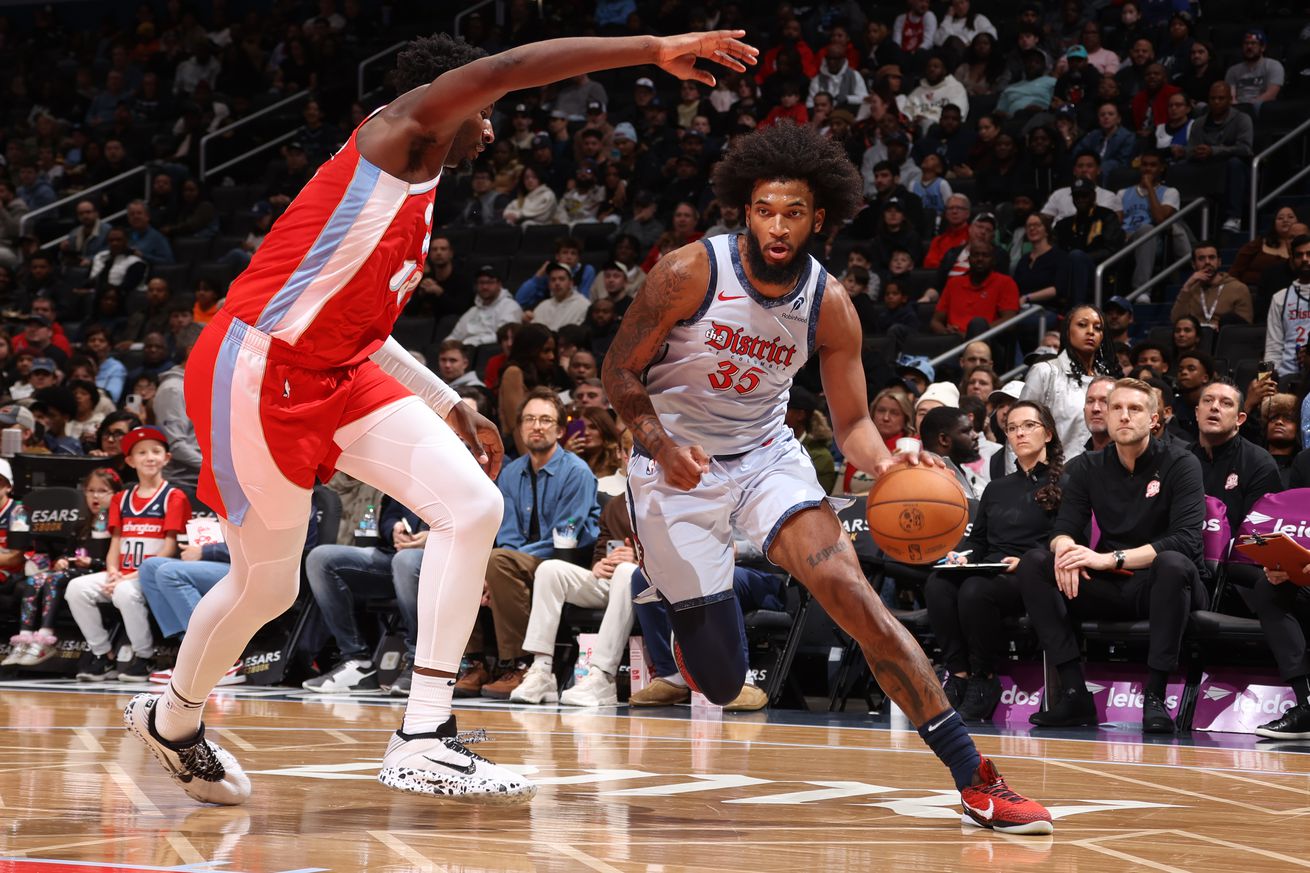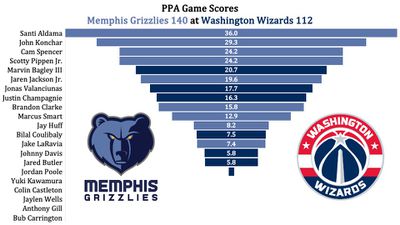
Stats, analysis, commentary.
So much for a winning streak. A night after ending a 16-game losing streak by beating Nikola Jokic and the Denver Nuggets, the Wizards got annihilated by the Memphis Grizzlies. Only a resolute performance from the garbage time mob kept Washington from losing by more than 30 points for a third time in four games. Instead, they lost by a mere 28.
For the Wizards, it was their 10th loss this season by 20 or more points and lowered their record to 3-19.
No one for the Grizzlies posted particularly eye-popping numbers — at least not the kind of gaudy glory stats (points, rebounds, assists) that produce headlines. That’s partly because they were winning so easily that no one needed to play much. Jaylen Wells led the team with 30 minutes, though he was also the team’s least productive player.
Next up in total minutes was Cam Spencer, brother of former Capital City Go-Go player Pat Spencer, who was appearing in his third NBA game. He posted 14 points, 4 rebounds, and 5 assists in 25 minutes of action. That tallied to a PPA (see below) of 197.
Jaren Jackson Jr. scored 21 points and blocked 4 shots in just 17 minutes of action. He collected his third foul after 12 minutes of playing time in the first half. He played a five-minute shift in the second half, which was thoroughly unnecessary.
How easy was this win for Memphis? They won the first quarter by 8 points, the second quarter by 9, and the third quarter by 12. The Wizards led once in the opening minutes, and steadily fell behind from there.
The Memphis defensive game plan was to contain Jordan Poole, and it worked. Former Defensive Player of the Year Marcus Smart played tough ball denial defense on Poole, as did Scotty Pippen Jr. and Wells. The Wizards committed several turnovers trying to get the ball to Poole. In the second half, they tried running sets that involved setting screens to free Poole up, and those failed too.
For some reason, the Wizards decided to have Poole stand in the corner for a few possessions, perhaps thinking he could serve as a decoy. Washington struggled to get into worthwhile offensive actions in what amounted to four-on-four.
The futility in getting Poole the ball, and his inability to shake free when they did, resulted in 12.7% usage — the third lowest usage rate of his Wizards career. His low was 9.4% on Jan. 5, 2024 in a loss at the Cleveland Cavaliers. His second lowest was Feb. 7, 2024 in a loss to Cleveland. Interesting note: his second lowest usage rate of the season (now third lowest) was 17.6% in a loss to Cleveland. Another interesting note: Washington’s next game is Friday against Cleveland. Poole usage rate watch party anyone?
Bright spots?
- Bilal Coulibaly played a sloppy, mistake-filled game, and for the first time in a few weeks, I liked the process. He took most of the open shots that came his way, and he drove repeatedly, got a paint touch, and then kicked out to open teammates. Stop at the glory stats — 17 points, 5 rebounds, 4 assists — and the game looks pretty good. He shot just 6-13, though, and he committed three turnovers and five fouls.
- Jonas Valanciunas mashed around inside and created some defensive challenges for the Grizzlies. The Wizards have to hope a contending front office sees this kind of game and coughs up a first round pick for the Lithuanian big man.
- Marvin Bagley III is an offensive rebounding machine. He grabbed five more in just 25 minutes to finish with 20 points, 7 rebounds, 2 assists, and 3 blocks. Don’t get too hyped about the blocks — Bagley did not defend well, and the team defense was just as abysmal when he was out there as it was with everyone else.
- After a career-best game the previous night against Denver, Justin Champagnie was decent — 14 points (6-12 from the floor), 8 rebounds, 5 steals.
- Not necessarily “bright” but definitely amusing (to me at least) — Washington’s 21 turnovers was truly a team effort. All nine players who got minutes committed at least one turnover. Eight had at least two (Bagley was the guy with one). Carrington, Jared Butler, Coulibaly, and Valanciunas each had three.
Four Factors
Below are the four factors that decide wins and losses in basketball — shooting (efg), rebounding (offensive rebounds), ball handling (turnovers), fouling (free throws made).
Stats & Metrics
Below are a few performance metrics, including the Player Production Average (PPA) Game Score. PPA is my overall production metric, which credits players for things they do that help a team win (scoring, rebounding, playmaking, defending) and dings them for things that hurt (missed shots, turnovers, bad defense, fouls).
Game Score (GmSC) converts individual production into points on the scoreboard. The scale is the same as points and reflects each player’s total contributions for the game. The lowest possible GmSC is zero.
PPA is a per possession metric designed for larger data sets. In small sample sizes, the numbers can get weird. In PPA, 100 is average, higher is better and replacement level is 45. For a single game, replacement level isn’t much use, and I reiterate the caution about small samples sometimes producing weird results.
POSS is the number of possessions each player was on the floor in this game.
ORTG = offensive rating, which is points produced per individual possessions x 100. League average last season was 114.8. Points produced is not the same as points scored. It includes the value of assists and offensive rebounds, as well as sharing credit when receiving an assist.
USG = offensive usage rate. Average is 20%.
ORTG and USG are versions of stats created by former Wizards assistant coach Dean Oliver and modified by me. ORTG is an efficiency measure that accounts for the value of shooting, offensive rebounds, assists and turnovers. USG includes shooting from the floor and free throw line, offensive rebounds, assists and turnovers.
+PTS = “Plus Points” is a measure of the points gained or lost by each player based on their efficiency in this game compared to league average efficiency on the same number of possessions. A player with an offensive rating (points produced per possession x 100) of 100 who uses 20 possessions would produce 20 points. If the league average efficiency is 114, the league — on average — would produced 22.8 points in the same 20 possessions. So, the player in this hypothetical would have a +PTS score of -2.8.
